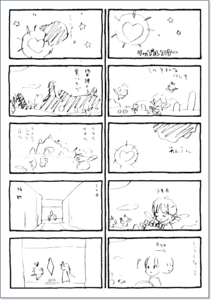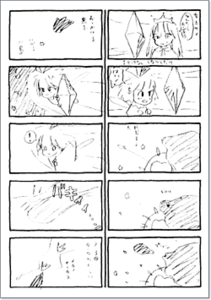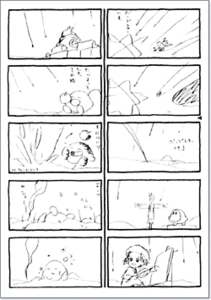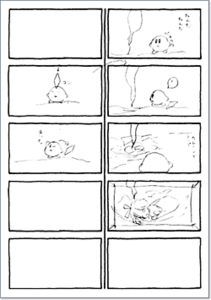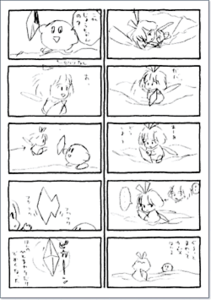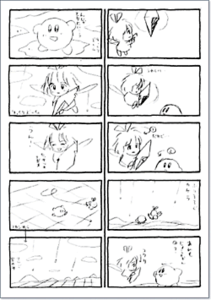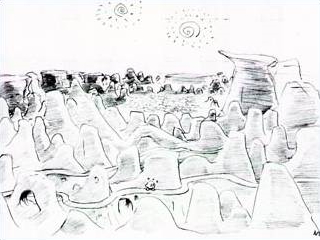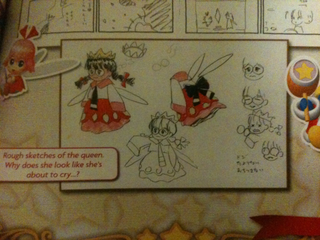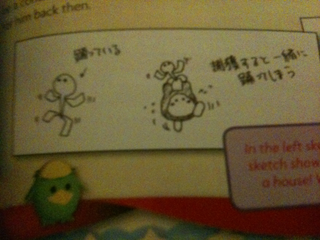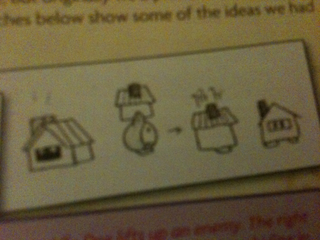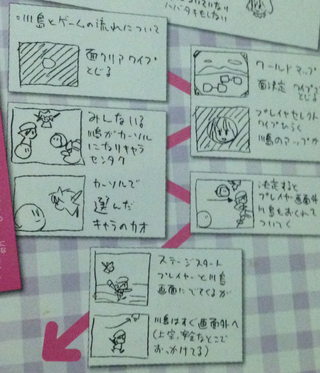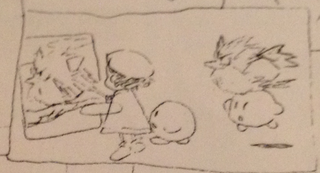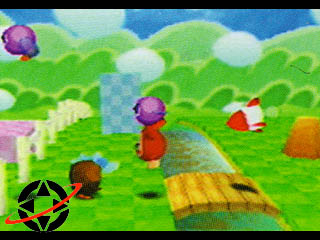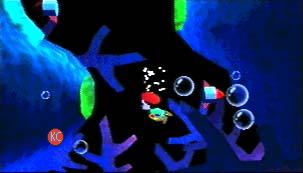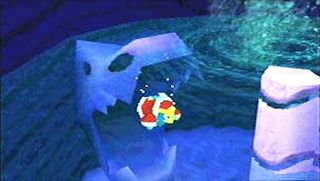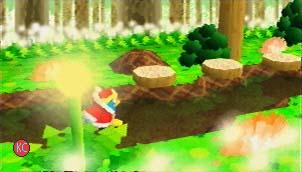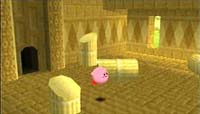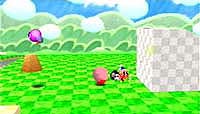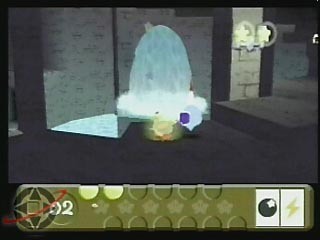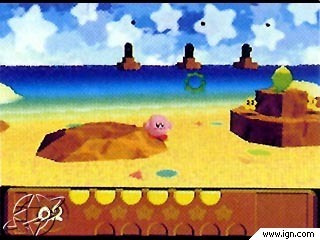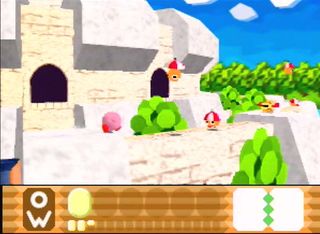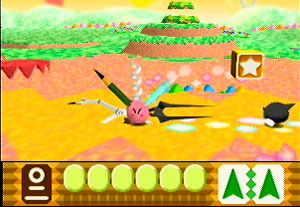Prerelease:Kirby 64: The Crystal Shards
This page details prerelease information and/or media for Kirby 64: The Crystal Shards.
| This article is a work in progress. ...Well, all the articles here are, in a way. But this one moreso, and the article may contain incomplete information and editor's notes. |
| To do: The end credits uses early designs for some characters, most notably Adeleine and Zero Two. |
Contents
Early Development
Development on Kirby 64 spanned over three years, beginning in September 1997 and ending sometime in February 2000. It was originally developed for the Nintendo 64DD, but due to the add-on's poor sales, the game was moved to the N64.
The earliest known Kirby 64 prototype was made in October of 1997, as an engine test to figure out how the game would play. The title screen for the prototype jokingly referred to the game as Kirby 64 Keroyon, or Kirby 64 Froggy. (Note that "64" is pronounced in Japanese as "Rokuyon", making it a pun.) From here until the Spaceworld 1999 prototype, Kirby 64 had a different control scheme where the joystick moved Kirby instead of the D-Pad, and the Z button was used for various actions. To make the game's controls easier for younger children to use, HAL's developers changed the scheme to use the D-Pad instead of the joystick, as well as remapping the Z button's actions to other buttons, rendering it useless in the final game.
Originally, all three of Kirby's friends - Waddle Dee, Adeleine, and King Dedede - would've been playable characters outside of the minigames. This concept made it all the way to the E3 1999 build of Kirby 64, before being removed sometime before the game was shown off at Spaceworld 1999. Ribbon, was intended to be the way the player would switch between these playable characters. In the final game, only King Dedede remained as a playable character, albeit in certain levels and with Kirby riding on his back.
The Animal Friends from Kirby's Dream Land 3 would have returned in this game as well, most likely through Adeleine painting them to assist Kirby, but the idea seems to have never gone past the concept art stage. They do make cameos in the Animal Statue copy ability, however, and their associated music tracks (one being unused) are still in the final game.
HAL Laboratory Website Concept Art
From mid-2000 to late 2001, HAL Laboratory's website had a gallery featuring concept art of Super Smash Bros., Pokémon Snap, and Kirby 64, the latter of which had two dedicated galleries.
Intro Storyboards
The first gallery documented a storyboard for the opening sequence with several differences from the final version. The first two pages are also seen in the collectible booklet included with Kirby's Dream Collection.
This storyboard (read left-down to right-down, excepting the fifth panel) features a completely different design for both Ripple Star and the Fairy Queen. Waddle Dee, Adeleine, and King Dedede are present and watching the crystal shards fall, reminiscent of how characters in the intro of Kirby's Dream Land 3 watched Dark Matter as it took over Pop Star. Kirby is also seen as he is about to eat an apple when Ribbon crash lands nearby; in the final game, Kirby was stargazing when Ribbon directly flies into him. The text present on the storyboards is mostly developers' notes, but there is also dialogue present. Whether this dialogue was just to explain the story or if it was meant to be implemented at some point is unknown.
Level Concept Art
The second gallery showcases various pieces of level concept art. Many ideas from these concepts would appear in the final game, albeit modified in one way or another.
"Riding a Whale", a callback to the whale encountered in Kirby's Dream Land and most likely meant for one of Aqua Star's levels. The only thing Kirby rides on the planet is a raft in the second level.
Kirby's Dream Collection Concept Art
A collectible booklet was packaged with the game Kirby's Dream Collection: Special Edition, which included some concept art for Kirby 64.
Fairy Queen
An early sketch of the Fairy Queen shows a different crown design near the upper left and a slightly different design for her skirt.
Waddle Dee
Two pieces of concept art which show off a part of Waddle Dee's moveset, back when the other three friends were meant to be playable. The first one shows Waddle Dee picking up and preparing to throw a scrapped humanoid enemy, a move that he shared with Kirby and which made it all the way to the E3 prototype, detailed below.
The other piece seems to show a scrapped house-like enemy which Waddle Dee could pick up and wear like a helmet. What this would've done is a mystery.
Scrapped Minigame
A music-based minigame was planned at one stage. In it, players would press the buttons as they appeared on-screen, while Kirby, Adeleine, King Dedede, and Waddle Dee played in a band.
Hoshi no Kābii Pupupu Taizen Concept Art
More concept art for Kirby 64 would be published in an art book that was released exclusively in Japan.
Ribbon
Ribbon's overall appearance stayed the same in her concept art, although her hair and ribbon went through a few design changes.
Stage Select/Character Select
This piece of concept art depicts several unimplemented features. It starts with selecting a planet (which made it into the final game), then goes to a world map with selectable stages. Once a stage was picked, players would pick a character to play as, using Adeleine as an example. At the start of a stage, Ribbon would fly ahead of the character and offscreen. In the final game, a sketchpad with drawings of each stage functions as a stage select screen, Kirby is the only playable character, and Ribbon only appears in a stage after collecting a crystal shard.
Desert Desserts Storyboard
This storyboard (which reads top-down, left-right) for Desert Desserts is extremely different from the final version and even the Spaceworld trailer. In this early version, Ribbon combines crystal shards with the main crystal, and when the group takes a break to eat, Kirby is eating different food. Ribbon is also shown to be eating something, while in the final game she merely watched everyone else. Furthermore, in the final game, when the portal to Aqua Star opens, Kirby has to be pulled into the portal by King Dedede; that scene is absent in the early storyboard.
Coo
Coo was an Animal Friend appearing in both Kirby's Dream Land 2 and Kirby's Dream Land 3. Coo, and likely the other Animal Friends, would've appeared in this game too, thanks to Adeleine painting them into existence. While this idea never made it to the final game, it somewhat resurfaced in Kirby and the Rainbow Curse, where Elline would transfer paintings onto Kirby and briefly transform him into an Animal Friend.
1999
At an unknown point before E3 1999, an early version of Kirby 64 was nearing completion. Instead of releasing it as-is later that year, HAL would end up tweaking and refining the game as late as February of 2000, a month before the game's Japanese release date.
Dengeki Nintendo 64
Two teaser images of Kirby 64 were shared in the September 1999 issue of Dengeki Nintendo 64, a Japanese gaming magazine dedicated to the Nintendo 64. Despite the issue being published in September, the images shown come from an earlier build of the game that was shown at E3 1999!
The most notable difference shown in the previews is a completely different HUD design. Aesthetically, the HUD goes for a dark, somewhat minimalist look, reminiscent of the final game's fifth HUD design. On the left are small portraits of the three scrapped playable characters, with labels indicating who was who, and a larger portrait meant for the active character.
In the middle of the HUD are three bars representing health, Point Stars, and the (mid-)boss' health. The final HUD makes the latter two share the same meter. Right next to the bars are vertical displays for Kirby's Power Combos, as well as three mysterious "RGB" counters that are stuck at 000. Perhaps they counted how many colored Point Stars the player had collected?
While unused, an earlier version of the E3 HUD's portraits can be found in the final game's data, and even includes portraits for all six Animal Friends.
E3 1999
Kirby 64's first public appearance was in May 1999 at E3, albeit a minor one; several seconds of cropped footage from the game were shown between clips of Super Smash Bros. A press kit by Nintendo confirmed that the footage was from a new Kirby game for the Nintendo 64, which would replace the previous title, Kirby's Air Ride.
The full, uncut footage would later appear on the French promotional tape "Catalogue Officiel '99", at 19:16. It shows off an early version of Rock Star 3 with a different appearance and enemy layout. Notably, the early level contains four enemies which do not appear in the final version of the level; a Bronto Burt, a Skud, a Bouncy, and a Rocky.
In addition, the clips show the old "RGB" HUD in action. A few clips in the teaser showcase Kirby using the regular Stone ability, which turns him brown instead of the grayish color seen in the final game. The ability also displays the icon from Kirby's Dream Land 2 and 3 in black - presumably, the rest of the abilities had similar-looking icons at this point. The final game would change the icon's appearance and also give them color.
The press kit also included a picture of the game, which shows Waddle Dee carrying a Bronto Burt in an early version of Pop Star. No word on whether the house-wearing move was implemented or not, though.
Nintendo.com
On June 1, 1999, nine teaser photos of Kirby 64 were released on Nintendo's website. Most of the pictures showcase the cut playable characters in action, while a few document some aquatic levels that were scrapped from the final game. Here, Adeleine is seen fighting a Mariel in an early version of Aqua Star 3, with a completely different sky, layout, and camera angle. All of those things were changed for the final game, with the Mariel removed from the level for good measure.
Adeleine swimming in an earlier version of Aqua Star 4's opening area; the terrain and background are darker, there are a lot more bubbles on-screen, and the holes which shoot enemies at the player are more pronounced. On the topic of the enemies, they appear to spawn Skuds instead of the Pedos found in the final game.
King Dedede about to clobber that there Gabon in Rock Star 3. Interestingly, Dedede's hammer appears to lack any textures in this screenshot and has a different, much squarer shape.
Another picture of King Dedede in Rock Star 3 - this time, he's swimming in some water near a giant skull and a bone (?) pillar. Much like the Adeleine in Aqua Star screenshot, this entire area was cut sometime after the photo was taken.
It's Dedede again! This time, he's standing in the rapids area of Aqua Star 2, if the background bushes are anything to go by. Strangely, the river appears to have no water in it whatsoever. The foreground dandelions and three log platforms were also removed.
Both of Waddle Dee's pictures are of him exploring the same area in Aqua Star 1. This cave entrance would be given a massive makeover and used as the level's Adeleine spawn in the final game.
The other picture shows him in the waterfall section. Apart from a camera angle change, all of the platforms were changed from grassy platforms with dirt blocks connecting them to brown and yellow checkerboards that were used earlier in the level.
And finally, we get to Kirby himself, exploring a very early version of the 'pool' room in Rock Star 2's ruins. It lacks the pool at this point, and has a darker floor texture and different walls, but sort of makes up for its shortcomings with some broken pillars.
The final image from Nintendo.com isn't particularly interesting - it shows Kirby standing in the early Pop Star level shown at E3, being further in the level than Waddle Dee was. It's only here for completion's sake, really.
Spaceworld 1999
Trailer
Kirby 64 would make its next appearance in August at Spaceworld 1999, as a trailer shown during the event. At this point, the game was 50% complete and had three playable levels, and the playable characters shown off earlier in the year had been removed. It's also the last version of the game to use the old joystick control scheme.
| Pre-release | Final |
|---|---|

|
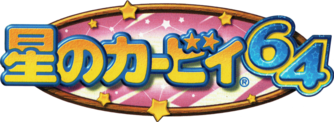
|
Kirby 64's logo was shown off for the first time at this event. It's clearly a work-in-progress, lacking the polish that the final version has. The early logo also has furigana for the pronunciation of "64", which is absent in the final version.
While the levels in this build are rather close to their final counterparts design-wise, some of their enemy spawns are quite different. For instance, a Flopper, Zoos, and Punc can be seen in Pop Star 1 and 3 respectively, neither of which appear on the planet in the final game. Three of the abilities shown in the trailer were changed for the final game:
- Ice + Bomb: Kirby covers himself with a large sphere of ice which explodes soon after. The final game has him transform into a snowman similar to Chilly, with Kirby as the body and a bomb as the head.
- Stone: Still has the brown coloration from the E3 build. In addition, he can still jump while in this form, which the final game prevents.
- Stone + Spark: Kirby turns into a computer chip which crushes enemies below him. The final has him levitate a boulder with electricity.
The Spaceworld build also has a unique HUD which seems to be halfway between the E3 HUD and the final version. Aesthetically, it lacks the wood grain texture of the final's default HUD, and the sides are curved instead of covering the entire bottom. The portraits from the E3 build have been replaced with three small boxes used to indicate the Crystal Shards acquired in the level. All of the meters from the E3 build are present, albeit with a design change; the health bars use notches in the HUD's sides, while the Point Star meter reuses the design from Kirby's Dream Land 3.
Finally, the ability icon display has been changed to be horizontal, although the abilities share the same box at this point. Speaking of, most of the ability icons are different in the trailer - the Stone and Cutter icons look more like their Kirby's Dream Land 3 versions, the Bomb icon has a lit fuse, and the top of the Spark icon is pointed instead of flat. Interestingly, the colors of the Needle and Cutter icons were swapped at this point - Needle is green, while Cutter is orange. This wouldn't be changed until the game was almost finished.
An early version of the "Desert Desserts" cutscene was also shown in this trailer. The background is different, having no dunes on the horizons, as well as a cloudier sky with a lighter hue. The shot after Kirby faints is shorter, and is positioned higher than the final. In addition, the party's reactions are also different; Adeleine seems more worried, Ribbon only tilts her head to the right, and King Dedede and Waddle Dee look at each other until the shot fades to white.
Pictures
In addition to the trailer, many pictures from the Spaceworld build of Kirby 64 would be released by IGN from August 28th until mid-November.
Kirby is stuck between some Gobblin on Rock Star, which are bigger and placed in the foreground.
A very early version of Rock Star's fourth level was shown in one picture.
- The bridge is made of wood instead of metal, has posts attached to it, and isn't broken. In addition, there are Spark-is and a N-Z on it.
- The entire layout has more grass to it.
- The pillars in the background aren't toppled over, and pink triangles are hovering above them.
- The pyramid itself is bright blue instead of black.
Two early screenshots of Kirby 64 were shared by IGN on September 7, 1999.
An early version of the inside of Dedede's castle. The hallway in the background has a straight railing, and an enemy Zoos is present; in the final game, there are sets of stairs in the background instead, and Sir Kibble appears in that room instead.
Another room in Dedede's castle, where the spiraling staircase is taller than in the final game. Both the icons for the Bomb and Spark abilities share half of a single box, as opposed to each ability having separate boxes in the final game.
Two months later, on November 15, IGN published another screenshot of Kirby 64, of an early version of the third stage in Aqua Star. The level layout is different, there are stars in the sky, and the cannons are situated much further away than they are in the final game.
2000
American Promo
An American promotional video for Kirby 64 shows that the Needle/Cutter color switch stayed until the game's development was nearly over. What's more interesting, however, is that the normal life meter shows Japanese numerals! The only HUD to have them is the fourth one in the Japanese version.
IGN
This picture is of an earlier version of the ending to the opening cutscene. There are yellow flowers to the left, and there's an extra path to the right.
Nintendo.com
Several pre-release photos were released on January 27, 2000. One of them shows the beginning of the opening cutscene, which has a skybox with more realistic clouds in the horizon. The final version of this scene changes these clouds to be in the shape of rings and hearts.
Another photo shows Kirby near Dedede's castle about to fight some Bumbers, which have a red coloration instead of violet. What's more interesting is that the life meter is flipped by 90 degrees for some reason, and isn't in Japanese numerals.
A massive amount of photos of Kirby 64 were released a month later on February 26, 2000 as a teaser. One of them shows a different form of Needle-Needle Kirby, which features a grey tuning fork that resembles the Spear of Longinus from Neon Genesis Evangelion on the right of Kirby. This was replaced with a potted cactus in the final game.
Another shows an early version of the player select screen for Checker Board Chase, with a different font for its hiragana.
In addition, the minigames page mentions a boulder in 100-Yard Hop that could slow the player's progress, which doesn't exist in the final game.
